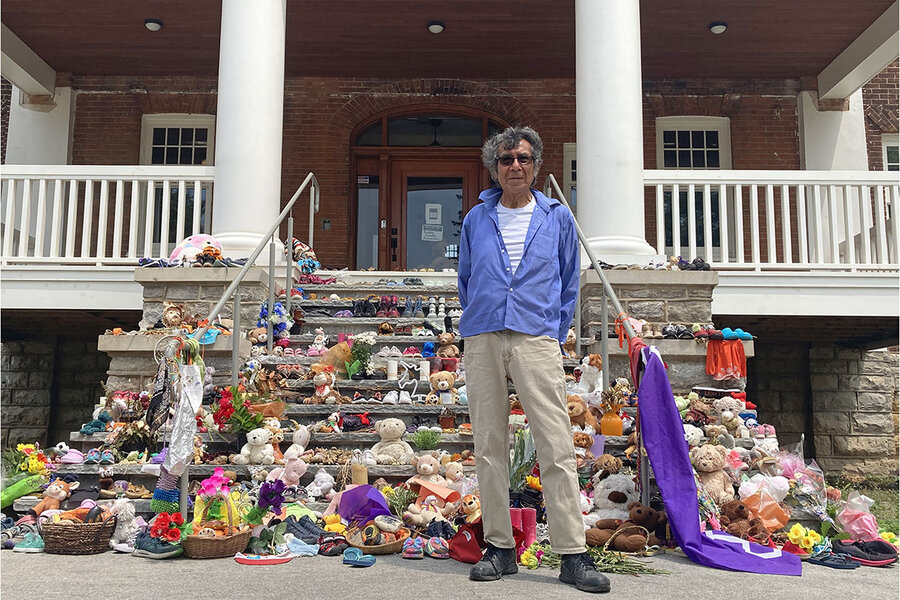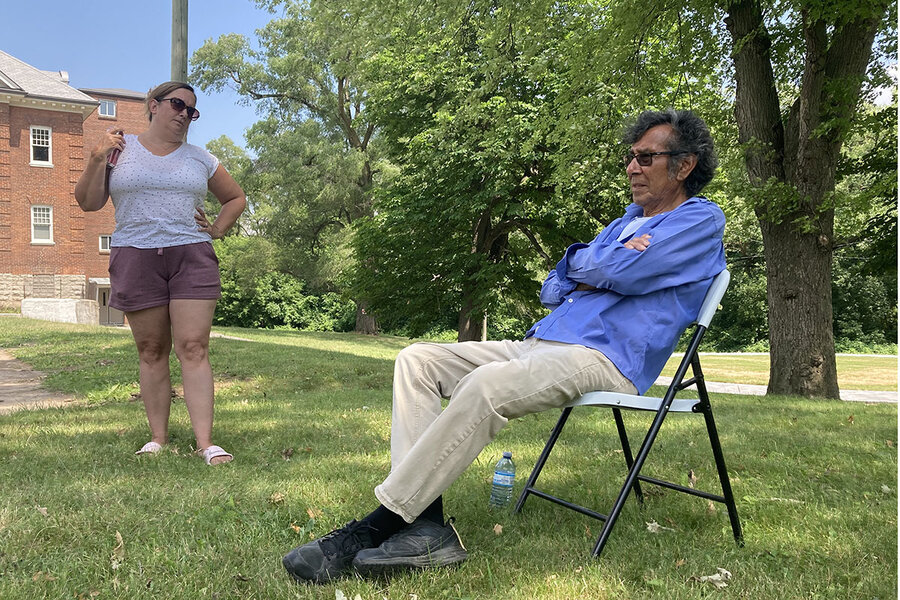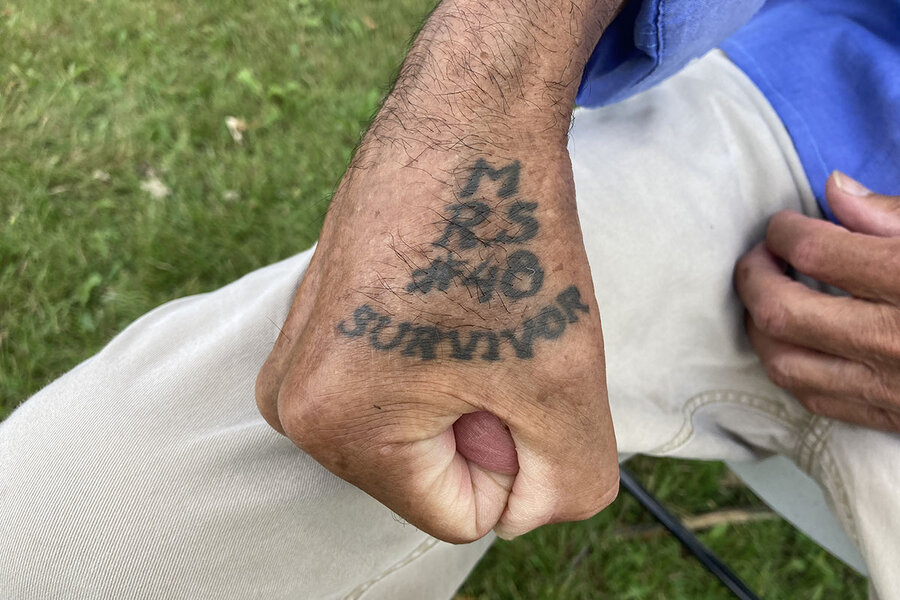Canada residential schools: Will hunt for Indigenous graves bring healing?
Loading...
| Brantford, Ontario
The discovery of unmarked graves at government-funded residential schools in Canada this year has not surprised the country’s Indigenous population. Survivors have long spoken of them. But the physical evidence has accelerated the push to locate remaining graves across the country.
And as more are found, Indigenous groups will face difficult questions about how to best heal in a long path forward from the intergenerational harms of Canada’s assimilation practices.
Why We Wrote This
After the discovery of unmarked children’s graves at several residential schools in Canada, Indigenous groups are demanding all such schools across the country be searched – not just for justice, but for healing.
Since the first discovery of the remains of an estimated 200 children in Kamloops, British Columbia, in late May, the federal government released an already allocated $27 million to aid Indigenous nations to search the grounds of more than 130 schools. But this latest chapter of discovery must go far beyond remembrance, says Chief Mark Hill of the Six Nations of the Grand River. “Someone has to be accountable,” he says. “How can you heal if we don’t have all the truth?”
“So many of the issues that we’ve seen today that Indigenous communities in Canada and elsewhere face can often be traced back to these systems that broke families,” says Kisha Supernant of the Institute of Prairie and Indigenous Archaeology. “If there’s any chance of having a healthy future, we have to do this work and hold people accountable and figure out a way forward.”
For years, Geronimo Henry couldn’t talk about the childhood he spent at the Mohawk Institute Residential School in southern Ontario. But when he found his voice, well into adulthood, he began a search for justice around his experience as an Indigenous child separated from his family in Canada’s vast assimilation experiment.
Today, Mr. Henry, who is in his 80s, gives talks to schools, churches, and community groups in Canada and the United States. He is raising funds to build a memorial wall that lists all the names of the Indigenous children who studied in this red-brick building throughout its 139-year history.
And now, after hundreds of unmarked graves of children were found near residential schools in British Columbia and Saskatchewan in the past six weeks, he is pushing for the grounds where he lived from 1942 to 1953 to be searched.
Why We Wrote This
After the discovery of unmarked children’s graves at several residential schools in Canada, Indigenous groups are demanding all such schools across the country be searched – not just for justice, but for healing.
“I demand it,” he says. “All of these schools were connected. What happened at one of them happened everywhere.”
Since the first discovery of the remains of an estimated 200 children in Kamloops, British Columbia, in late May, the federal government released an already allocated $27 million to aid Indigenous nations to search the grounds of the more than 130 schools that were part of a church-run, government-funded network that a Truth and Reconciliation Commission (TRC) concluded in 2015 had been created for “cultural genocide.”
The discovery of unmarked graves has not surprised Indigenous Canada. Survivors have long spoken of them. But the physical evidence, made possible with ground-penetrating radar technology, has accelerated the push to locate remaining graves across the country. And as more are found – many experts say the findings to date are just the beginning – Indigenous groups, disparate in their beliefs, will face difficult questions about how to best heal in a long path forward from the intergenerational harms of Canada’s assimilation practices, which only formally ended in 1996.
“Bringing these children back to the community and bringing their spirits home is such an important part of the healing process,” says Kisha Supernant, director of the Institute of Prairie and Indigenous Archaeology in Edmonton, who has been working on uncovering mass graves since 2008. “So many of the issues that we’ve seen today that Indigenous communities in Canada and elsewhere face can often be traced back to these systems that broke families, literally took them apart. … If there’s any chance of having a healthy future, we have to do this work and hold people accountable and figure out a way forward.”
“How can you heal if we don’t have all the truth?”
On the Six Nations of the Grand River, Canada’s largest reserve west of Toronto and site of the Mohawk Institute Residential School, Chief Mark Hill wrote an open letter demanding a full search and criminal investigation to find possible remains on the reserve’s grounds. The community has sought $10 million to search an area that spans 350 acres, he says.
Two areas around the school had been previously searched, but the institute’s physical location changed multiple times. It burned down twice. Chief Hill says survivors speak of two former farms where they labored and believe remains could be. That land could be in private hands today. The complexity of the search suggests federal funds won’t meet the needs of Indigenous communities across the country.
The Mohawk Institute Residential School opened its doors in 1831 and was first originally operated by the Anglican Church. It didn’t close its doors until 1970.
Six Nations has been a leader in cultural revival. Two years after the school closed, the Woodland Cultural Centre opened as a thriving cultural space. It currently offers virtual tours of the former school – of the exterior walls where students etched their names, of windows where children tried to escape, and of pipe systems in dorms that children used as play structures when adults weren’t looking.
But Chief Hill is clear that this latest chapter of discovery must go far beyond remembrance and commemoration. “Someone has to be accountable,” says Chief Hill. “These are crimes committed against human beings. How can you heal if we don’t have all the truth?”
Six Nations anticipates the need for psychological services will grow along the way. “I feel for communities right now who are having to go through this, and obviously we will have to as well,” says Janis Monture, executive director of the Woodland Cultural Centre.
“Resolution has to come from within the community”
Not all communities are unanimous in their ideas of what to do next, says Eldon Yellowhorn, founding chair of Indigenous studies at Simon Fraser University, who has worked on the Missing Children Project initiated by the TRC. He is currently leading a team of experts to identify the names of the people buried in 104 unmarked graves in Brandon, Manitoba.
Mr. Yellowhorn says he sees a split between those who want to leave cemeteries where they are and build memorials, and those who want remains returned home. “That’s something that the Native community is going to have to come to some kind of agreement [around], and it could get ugly, especially as people start hiring lawyers and suing for one reason or another. That’s going to drag things on, and it will require some kind of resolution,” he says. “Ultimately, that resolution has to come from within the community. It can’t be one that’s imposed.”
Dr. Supernant says that requests for her services have accelerated and outstripped supply – a specialty that she estimates only about two dozen have in Canada – which shows her that most communities are ready to move forward on searching. But the discoveries have also elicited growing calls for criminal investigations, and that is where she says questions could become more difficult. “It is one thing to take out ground-penetrating radar and locate possible graves,” she says. “It’s entirely another to do a forensic investigation.”
It’s more complicated because children in these schools came from far and wide, so that one school is not attached to one Indigenous community but multiple. At the Mohawk Institute Residential School, some students came from as far as the Yukon Territory.
But most would have been neighbors of Debbie Bickford, who grew up in the next town from Brantford – a history that she says she can’t bear today. Outside the school, a vigil has overtaken the front steps. Weeks after the first discovery at a school in Kamloops, visitors in the middle of a summer weekday arrive at a constant clip. The majority are non-Indigenous Canadians like Ms. Bickford saying they are learning about the abuses of residential schooling for the first time.
“Everything I believe is in question,” she says. “When I heard about these kids, I’m like, there’s something huge these people have been trying to tell us for a long time.”
Many approach Mr. Henry, who often shows up at the school to answer their questions. He tells them about malnutrition – survivors called the school the “Mush Hole” – and how the children were identified by number, not name. His was 48. He shows them the crease in his hand where he had tattooed “MRS #48 Survivor,” a constant reminder of the dehumanizing experience that he lived.
He says he is often asked how difficult it is for him to stand on these grounds. He still gets sad at this time of year, the summer months when other kids went home until the fall, he says. He arrived at age 6, and at the end of the school year would wait by a window at the boarding school for his family to pick him up, but they never did. He didn’t leave until he was 17. “It’s kind of like my home, even though it’s sad to say,” says Mr. Henry.
A search for truth brings him back. “I’ve wanted to get justice for all the kids that went to residential schools. For those people that still can’t talk about it to this day, with the trauma they experienced, whether it was physical, mental, psychological, or sexual,” he says. “And this is especially for those who already passed on that never got justice.”
Ryan Yu contributed reporting to this article.










